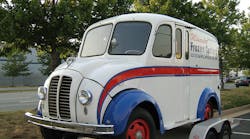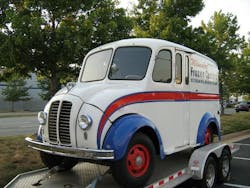Near the beginning of the 20th century, there were two things that most Americans could count on: mail delivery from the U.S. Postal Service, and a weekly visit from the milkman.
Back before we had modern refrigeration systems, we had the milkman, who would bring fresh milk to our doorstep when we needed it. And to get that milk to our doors required specialized transportation – the milk truck.
Recently, there was a gathering of some of those old milk trucks in Springfield, IL, as part of the DIVCO Club of America’s 25th anniversary convention. According to an article in the State Journal-Register, the vehicles on display covered most decades, from the 1920s through 1986. The article noted that the DIV CO-produced milk truck was second longest produced vehicle in the U.S., behind only the iconic Volkswagen Beetle.
“They were kind of a unique-looking delivery truck, snub-nosed with a rounded front end like a Volkswagen Beetle,” Ken Lego, past president of the DIVCO Club, told the paper. “A lot of dairies, bakeries, laundry companies and diaper services used them. They were a pretty handy truck to use for deliveries to homes because you could stand up and drive them besides sitting down.”
So, while we are all no doubt familiar with the milk truck, I found the history of the DIVCO company and how the trucks actually came about quite interesting.
According to the DIVCO Club of America website, George Bacon, who was chief engineer for the Detroit Electric Vehicle Co. in 1922, developed a concept milk truck that allowed the driver to operate it from either side of the cab, from the front, or the back of the vehicle. However, because George’s concept featured a gasoline engine, his employer was not excited, so he and some other investors left to form the Detroit Industrial Vehicle Co. (DIVCO).
After testing the company produced its first production vehicle in 1926. The DIVCO website explains the first vehicle this way:
“This went onto the market in 1926 as the ‘Divco’, powered by a 4-cylinder Continental engine with Warner 4-speed transmission. The first 25 Divcos were forward-control vans with a front-hinged door through which the driver could step ahead of the axle. Control from the running boards was also possible. But development of such a specialized ‘Multi-Stop’ vehicle was expensive. Among unexpected expenses were the design of heavier brakes, clutch and generating systems than most vehicles of the time required. New capitol was needed, and the company was reorganized in 1927 as the Divco Detroit Corporation.”
To read more about the history of DIVCO, visit the DIVCO Club of America.
The company added more models over the years, including the 1929 Model G, which featured a short hood and van or open-sided body. A short time later, the Model H, with a drop frame for a walk-through aisle, was added.
During the depression, the company suffered financially and Divco Detroit was purchased by Continental Motors and renamed Continental-Divco Corp. in 1932.
More models followed, including the 1933 Twin Coach.
Another change to the business occurred in 1936, resulting in the company merging with Twin Coach Co. of Kent, OH, before finally ending up with the name Divco Corp. following World War II.
The final, most recognizable Divco model can in 1939. Here’s how the Divco Club’s website describes that model:
“In 1937 the Divco was completely redesigned with a welded all-steel van body and a snub-nosed hood which was used with virtually no change up to the end of production. A huge new plant was built on Hoover Road near Detroit to manufacture the first snub-noses which appeared in service in 1939. The doors were of the folding, semi-automatic type, and the power unit was still a 4-cylinder Continental. In 1940 the first insulated and refrigerated unit was built. But production was stopped so the plant could be used for war materials during WWII. After the war, the 1946 Divcos were basically similar to pre-war, and came in two wheelbases, the 100-3/4 inch Model UM and 127 inch model ULM. GVW were 9000 and 12,000 lbs. and engines were 4- and 6-cylinder Continentals.”
Early models of the milk truck featured packed ice to keep the milk cold and it wasn’t until 1954 that refrigeration vans were offered as a regular production option. Because of the longevity of the vehicles, though, many milkmen continued to pack their products on ice.
The final Divco model arrived in 1986.




